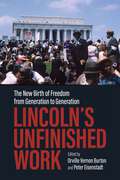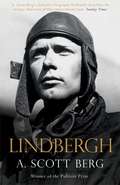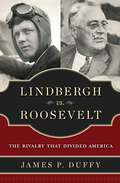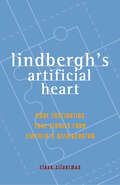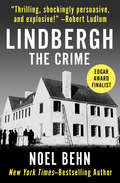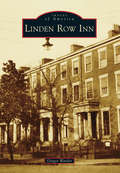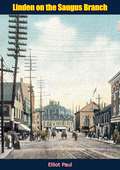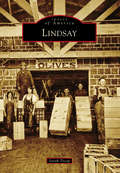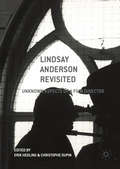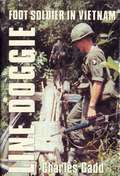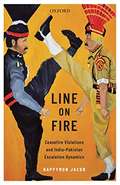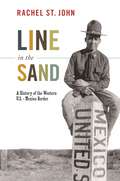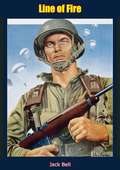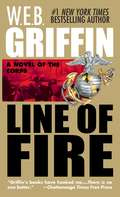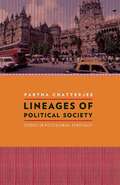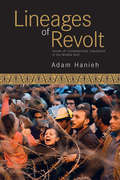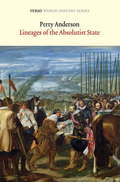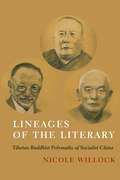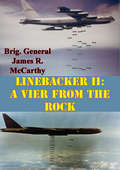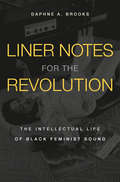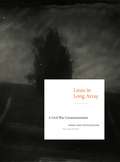- Table View
- List View
Lincoln’s Unfinished Work: The New Birth of Freedom from Generation to Generation
by Eric Foner Richard Carwardine Mark Schultz Jerald Podair Gavin Wright Stephen Kantrowitz William Haller J. William Harris Randall Stephens Joshua Casmir Catalano Greg Downs James Loewen Lawrence McDonnell Adrienne Petty Briana Pocratsky Rhondda ThomasIn his Gettysburg Address, Abraham Lincoln promised that the nation’s sacrifices during the Civil War would lead to a “new birth of freedom.” Lincoln’s Unfinished Work analyzes how the United States has attempted to realize—or subvert—that promise over the past century and a half. The volume is not solely about Lincoln, or the immediate unfinished work of Reconstruction, or the broader unfinished work of America coming to terms with its tangled history of race; it investigates all three topics.The book opens with an essay by Richard Carwardine, who explores Lincoln’s distinctive sense of humor. Later in the volume, Stephen Kantrowitz examines the limitations of Lincoln’s Native American policy, while James W. Loewen discusses how textbooks regularly downplay the sixteenth president’s antislavery convictions. Lawrence T. McDonnell looks at the role of poor Blacks and whites in the disintegration of the Confederacy. Eric Foner provides an overview of the Constitution-shattering impact of the Civil War amendments. Essays by J. William Harris and Jerald Podair examine the fate of Lincoln’s ideas about land distribution to freedpeople. Gregory P. Downs focuses on the structural limitations that Republicans faced in their efforts to control racist violence during Reconstruction. Adrienne Petty and Mark Schultz argue that Black land ownership in the post-Reconstruction South persisted at surprisingly high rates. Rhondda Robinson Thomas examines the role of convict labor in the construction of Clemson University, the site of the conference from which this book evolved. Other essays look at events in the twentieth and twenty-first centuries. Randall J. Stephens analyzes the political conservatism of white evangelical Christianity. Peter Eisenstadt uses the career of Jackie Robinson to explore the meanings of integration. Joshua Casmir Catalano and Briana Pocratsky examine the debased state of public history on the airwaves, particularly as purveyed by the History Channel. Gavin Wright rounds out the volume with a striking political and economic analysis of the collapse of the Democratic Party in the South.Taken together, the essays in this volume offer a far-reaching, thought-provoking exploration of the unfinished work of democracy, particularly as it pertains to the legacy of slavery and white supremacy in America.
Lindbergh vs. Roosevelt: The Rivalry That Divided America
by James P. DuffyWas aviation pioneer and popular American hero Charles A. Lindbergh a Nazi sympathizer and anti-Semite? Or was he the target of a vicious personal vendetta by President Roosevelt? In Lindbergh vs. Roosevelt, author James Duffy tackles these questions head-on, by examining the conflicting personalities, aspirations, and actions of Franklin D. Roosevelt and Charles A. Lindbergh. Painting a politically incorrect portrait of both men, Duffy shows how the hostility between these two American giants divided the nation on both domestic and international affairs. From canceling U.S. air mail contracts to intervening in World War II, Lindberg and Roosevelt's clash of ideas and opinions shaped the nation's policies here and abroad. Insightful, and engaging, Lindbergh vs. Roosevelt reveals the untold story about two of history's most controversial men, and how the White House waged a smear campaign against Lindbergh that blighted his reputation forever.
Lindbergh's Artificial Heart: More Fascinating True Stories from Einstein's Refrigerator
by Steve SilvermanAn all-new compendium of strange-but-true history and science facts from the author of Einstein&’s Refrigerator. When high school teacher Steve Silverman started posting fascinating facts on the internet, what began as a Web site for his students became an internationally sensation. He then compiled the silliest, most peculiar stories into the book Einstein's Refrigerator. Now comes silliness squared with Lindbergh's Artificial Heart, Silverman's second collection of offbeat and often hilarious stories that are absolutely true, yet not often taught in school. Fascinating entries include: The exploding whale: What did the Oregon Department of Transportation do with a dead whale that washed up on one of its beaches? Suffice it to say their decision to blow it up was quite the blubber blunder. Nose picking: Delve into the humorous findings of a study of this bad habit conducted by one of our institutions of higher learning. The fastest charcoal lighter ever: Using liquid oxygen at your family barbecue may speed up the cooking, but it does have its drawbacks . . . such as vaporizing your grill.
Lindbergh: The Crime
by Noel BehnEdgar Award Finalist: This &“sensational&” and &“absolutely compelling&” true crime tale finally answers the question: Who really killed the Lindbergh baby? (San Francisco Chronicle). On the night of March 1, 1932, celebrated aviator Charles Lindbergh&’s infant son was kidnapped from his New Jersey home. The family paid $50,000 to get &“Little Lindy&” back, but his remains were discovered in a grove of trees four miles from the Lindbergh house. More than two years after the abduction, Bruno Hauptmann, an unemployed carpenter and illegal German immigrant, was caught with $20,000 of the ransom money. He was arrested, tried, and executed for the crime. But did he really do it? New York Times–bestselling author Noel Behn spent eight years investigating the case, revisiting old evidence, discovering new information, and shining a bright light on the controversial actions of public figures such as New Jersey Governor Harold Hoffman, FBI Director J. Edgar Hoover, New Jersey State Police Superintendent H. Norman Schwarzkopf, and Charles Lindbergh himself. The result is a fascinating and convincing new theory of the crime that exonerates Hauptmann and names a killer far closer to the Lindbergh family. A finalist for the Edgar Award, Lindbergh &“not only provides answers to the riddles of the &‘Crime of the Century,&’ but hurls us into time past, to a special moment in American history&” (Peter Maas, New York Times–bestselling author of Underboss).
Linden Row Inn
by Ginger WarderIncluded in the National Register of Historic Places, the collection of Greek Revival row houses that make up the Linden Row Inn have played a significant role in the history of Richmond, Virginia, for two centuries. As a child, Edgar Allan Poe played in the private garden that occupied this site, and he later courted his first love, Elmira Royster, among the roses and linden trees. During the Civil War, Linden Row was a meeting place for leaders and supporters of the Confederacy; later, it was home to a prestigious girls' school, whose pupils included Irene and Nancy Langhorne, known in later years as the Gibson Girl and Lady Nancy Astor. In 1922, two of the original ten houses were torn down and replaced by the Medical Arts Building. In 1950, local preservationist Mary Wingfield Scott purchased the remaining houses to save them from the wrecking ball, donating them in 1980 to the Historic Richmond Foundation. In 1988, under the supervision of the foundation, seven of the eight remaining houses were renovated and restored to become the Linden Row Inn, which still welcomes travelers today.
Linden on the Saugus Branch (American Autobiography Ser.)
by Elliot PaulThat you will be completely charmed by Elliot Paul’s recollections of his boyhood is a matter beyond speculation. The turn-of-the-century scenes are not only dear to his heart but clear to his mind—albeit sometimes suspiciously so. But who will quarrel with so elegant a storyteller as Mr. Paul? Out of the sow’s ear of common occurrence he makes a silken purse to hold the coins of our enchantment. Rare is the reader who will not delight in these fortified memories.Those who recall The Last Time I saw Paris know that Elliot Paul is incapable of being banal or tiresome. Thus there is nothing of the diary-like march of events in this record of his early years in the Boston suburb where he was born. Instead you will find a series of neatly dovetailed stories, anecdotes, character sketches, comedies, tragedies and singularly embellished observations all set out for your allurement like gems in a jeweler’s window.Some of Mr. Paul’s tales of the people who lived out their lives in Linden will make you laugh, some may even tempt a tear. There are a few—such as the story of Alice Townsend, the schoolteacher who found that her name had been written in snow with a stylus of strange origin—that may inspire the sincerest suggestion of a blush.Linden on the Saugus Branch, a volume complete in itself, is another segment in what will ultimately be Elliot Paul’s life story: Items on the Grand Account. Both The Last Time I Saw Paris and The Life and Death of a Spanish Town are other books in this group.
Lindsay (Images of America)
by Sarah TroopA picturesque town nestled among the wildflower-covered foothills of the Sierras, Lindsay is the epitome of the ideal California life--one of health, wealth and sunshine. Lindsay became the heart of the state's second gold rush, when large-scale farming became popular, by hitting the mother lode with oranges. With over 16 citrus packinghouses, people initially came to Lindsay to seek their fortune. The success of the citrus groves attracted not only many skilled Japanese farmers but also many immigrants who were new to the trade. By the 1920s, Lindsay's most famous crop became Lindsay Ripe Olives. Lindsay is a town of surprising inventions and innovations that revolutionized agriculture, citrus farming, irrigation, and especially the olive industry.
Lindsay Anderson Revisited
by Erik Hedling Christophe DupinThis book is about the British film-maker Lindsay Anderson. Anderson was a highly influential personality within British cinema, mostly famous for landmark films like This Sporting Life (1963) and If. . . . (1968). Lindsay Anderson Revisited deals primarily with hitherto unexplored aspects of his career: his biographical background in the British upper class, his devoted film criticism, and his angry relationship to contemporary society in general. Thus, the book contains chapters about his childhood in India, his writings about John Ford, his relationship to French star Serge Reggiani, his work on TV in the 1950s, his troubles with the British film establishment, and his gradually emerging preoccupation with being Scottish, not English. Also featured are chapters written by close friends of Anderson, who died in 1994, dwelling on his penchant for controversy and quarrel, but also on his remarkable artistic talent and commitment.
Lindy Chamberlain: The Full Story
by Ken CrispinThe true story of a mother accused of murdering her baby in the outback of Australia.
Line Doggie: Foot Soldier in Vietnam
by Charles GaddCharles Gadd served in Vietnam in late 1967 and 1968 and had experiences very similar to what most enlisted men endured. He describes the mud, blood, leeches, loss of friends, and low morale due to constant harassment by guerrillas. The author, a squad leader with the 101st Airborne, was wounded twice and saw nearly constant action in the Central Highlands. This memoir is a vivid and accurate description of the Vietnam War.
Line On Fire: Ceasefire Violations And India-pakistan Escalation Dynamics (Oxford International Relations In South Asia)
by Sumit Ganguly E. Sridharan Happymon JacobThe India–Pakistan border in Jammu & Kashmir has witnessed repeated ceasefire violations (CFVs) over the past decade. As relations between India and Pakistan have deteriorated, CFVs have increased exponentially. It is imperative to gain a deeper understanding of these violations owing to their potential to not only cause a crisis but also escalate an ongoing one. Line on Fire, part of the Oxford International Relations in South Asia series, postulates that the incorrect diagnosis of the reasons behind CFVs has led to wrong policies being adopted by both India and Pakistan to deal with the recurrent violations. Using fresh empirical data and first-hand accounts, the volume attempts to understand the reason why CFVs continue to take place between India and Pakistan despite consistent efforts to reduce the tension between the two nations. In doing so, it recontextualizes and enriches the prevailing arguments in contemporary literature on escalating dynamics and unenduring ceasefire agreements between the two South Asian nuclear rivals.
Line in the Sand: A History of the Western U.S.-Mexico Border (America in the World #11)
by Rachel St. JohnThe first transnational history of the U.S.-Mexico borderLine in the Sand details the dramatic transformation of the western U.S.-Mexico border from its creation at the end of the Mexican-American War in 1848 to the emergence of the modern boundary line in the first decades of the twentieth century. In this sweeping narrative, Rachel St. John explores how this boundary changed from a mere line on a map to a clearly marked and heavily regulated divide between the United States and Mexico. Focusing on the desert border to the west of the Rio Grande, this book explains the origins of the modern border and places the line at the center of a transnational history of expanding capitalism and state power in the late nineteenth and early twentieth centuries.Moving across local, regional, and national scales, St. John shows how government officials, Native American raiders, ranchers, railroad builders, miners, investors, immigrants, and smugglers contributed to the rise of state power on the border and developed strategies to navigate the increasingly regulated landscape. Over the border's history, the U.S. and Mexican states gradually developed an expanding array of official laws, ad hoc arrangements, government agents, and physical barriers that did not close the line, but made it a flexible barrier that restricted the movement of some people, goods, and animals without impeding others. By the 1930s, their efforts had created the foundations of the modern border control apparatus.Drawing on extensive research in U.S. and Mexican archives, Line in the Sand weaves together a transnational history of how an undistinguished strip of land became the significant and symbolic space of state power and national definition that we know today.
Line of Advantage: Japan’s Grand Strategy in the Era of Abe Shinzō (Contemporary Asia in the World)
by Michael GreenNo other country has devised a grand strategy for managing China’s rising economic and military power as deliberately or successfully as Japan. Seeking to counter Chinese ambitions toward regional hegemony, Japan has taken an increasingly assertive role in East Asia and the world. During the tenure of Prime Minister Abe Shinzo, the country pursued closer security cooperation with the United States and other democracies, established a more centralized national defense system, and advanced rules and norms to preserve the open regional order in the Indo-Pacific that is crucial to its prosperity and survival—all while managing an important economic relationship with China.In Line of Advantage, Michael J. Green provides a groundbreaking and comprehensive account of Japan’s strategic thinking under Abe. He explains the foundational logic and the worldview behind this approach, from key precedents in Japanese history to the specific economic, defense, and diplomatic priorities shaping contemporary policy toward China, the United States, the two Koreas, and the Indo-Pacific region. Drawing on two decades of access to Abe and other Japanese political, military, and business leaders, Green provides an insider’s perspective on subjects such as how Japan pursued competition with China without losing the benefits of economic cooperation. Assessing the strengths and weaknesses of Japan’s new active role, Line of Advantage sheds new light on a period with profound implications for the future of U.S. competition with China and international affairs in Asia more broadly.
Line of Fire
by Jack BellTHE STORY OF WORLD WAR II’S LOWEST COMMON DENOMINATOR—THE FIGHTING MANOriginally published in 1948, this is the fascinating account of U.S. soldiers fighting in East Asia and Europe, as seen firsthand by an American journalist, Jack Bell of the Chicago Daily News.“Jack Bell spent his time with the fighting men, usually where the fighting was the thickest. He knew the troops and lived with them. He was the kind of a correspondent who would patrol the frontal areas, get voluminous motes, go back to his typewriter and write enough stuff to fill his requirements for a week, then go out again for another basketful of names and hometowns.“He saw and knew the war as it really was—the machine gunner sweating out the next attack; the advancing BAR man clinging closely to a stone wall; the lonely man on an outpost listening with every pore of his body; the exhilaration and excitement of intense firing and fighting and the depressing feeling that came with surveying the killed and wounded in the silence that followed. He knew all of it and much more. He knew the people that fought it, their fear, their worries, and their moments of greatness. And this, finally, is the essence of war. For it is a composite of men, gun crews, air crews, seamen, and thousands of small fighting teams, all of whom regardless of their origins and fears do their jobs when the chips are down. It is these things rather than broad arrows on bright maps with thumb smudged evidences of staff cerebrations that is war. And this was Jack Bell’s war.”—James M. Gavin
Line of Fire (Corps #5)
by W.E.B. GriffinLine of Fire brings to life a desperate mission of World War II that captures the drama and courage of the men who fought it. Two Marines, reporting on Japanese air activity, are trapped on a small Coastwatcher island. A special rescue team is assembled to save them--under enemy gunsight. It is am exciting and powerful story of real heroism that only W.E.B. Griffin could tell...
Lineages of Brahman Power: Caste, Family, and the State in Western India, 1600–1900 (SUNY series in Hindu Studies)
by Rosalind O'HanlonTraces the role that western India's influential Brahman communities played in shaping India's modern caste system.Western India's Brahman communities have played a key role in the shaping of India's modern caste system. In Lineages of Brahman Power, Rosalind O'Hanlon focuses on their rise to power between the seventeenth and nineteenth centuries, exploring the ways in which some Brahman intellectuals sought to defend the hierarchies of caste against the social changes of the early modern era while others looked for compromise. Drawing on Marathi vernacular sources, O'Hanlon also examines the household, family, and lineage as key sites for Brahman accumulation of skills and cultural capital. This approach also reveals Brahman identity itself as contested, as Brahman subcastes competed with each other not only for service positions and state patronage but also to define who could actually be considered a Brahman, and of what kind. This focus on Brahman social history is novel, in that most historians focus on Brahman power as emerging out of their religious prestige and dominance of intellectual and literary cultures. The emphasis on Brahman identity itself as complex and internally contested also helps to avoid essentializing Brahman power as always and everywhere the same.
Lineages of Political Society: Studies in Postcolonial Democracy (Cultures of History)
by Partha ChatterjeePartha Chatterjee, a pioneering theorist known for his disciplinary range, builds on his theory of "political society" and reinforces its salience to contemporary political debate. Dexterously incorporating the concerns of South Asian studies, postcolonialism, the social sciences, and the humanities, Chatterjee broadly critiques the past three hundred years of western political theory to ask, Can democracy be brought into being, or even fought for, in the image of Western democracy as it exists today? Using the example of postcolonial societies and their political evolution, particularly communities within India, Chatterjee undermines the certainty of liberal democratic theory in favor of a realist view of its achievements and limitations. Rather than push an alternative theory, Chatterjee works solely within the realm of critique, proving political difference is not always evidence of philosophical and cultural backwardness outside of the West. Resisting all prejudices and preformed judgments, he deploys his trademark, genre-bending, provocative analysis to upend the assumptions of postcolonial studies, comparative history, and the common claims of contemporary politics.
Lineages of Revolt
by Adam HaniehWhile the outcomes of the tumultuous uprisings that continue to transfix the Arab world remain uncertain, the root causes of rebellion persist. Drawing upon extensive empirical research, Lineages of Revolt tracks the major shifts in the region's political economy over recent decades. In this illuminating and original work, Adam Hanieh explores the contours of neoliberal policies, dynamics of class and state formation, imperialism and the nature of regional accumulation, the significance of Palestine and the Gulf Arab states, and the ramifications of the global economic crisis. By mapping the complex and contested nature of capitalism in the Middle East, the book demonstrates that a full understanding of the uprisings needs to go beyond a simple focus on "dictators and democracy."
Lineages of the Absolutist State
by Perry AndersonThe political nature of Absolutism has long been a subject of controversy within historical materialism. Developing considerations advanced in Passages from Antiquity to Feudalism, this book situates the Absolutist states of the early modern epoch against the prior background of European feudalism. It is divided into two parts. The first discusses the overall structures of Absolutism as a state-system in Western Europe, from the Renaissance onwards. It then looks in turn at the trajectory of each of the specific Absolutist states in the dominant countries of the West--Spain, France, England and Sweden, set off against the case of Italy, where no major indigenous Absolutism developed. The second part of the work sketches a comparative prospect of Absolutism in Eastern Europe. The peculiarities, as well as affinities, of Eastern Absolutism as a distinct type of royal state, are examined. The variegated monarchies of Prussia, Austria and Russia are surveyed, and the lessons asked of the counter-example of Poland. Finally, the structureof the Ottoman Empire in the Balkans is taken as an external gauge by which the singularity of Absolutism as a European phenomenon is assessed. The work ends with some observations on the special position occupied by European development within universal history, which draws themes from both Passages from Antiquity to Feudalism andLineages of the Absolutist State together into a single argument--within their common limits--as materials for debate.
Lineages of the Literary: Tibetan Buddhist Polymaths of Socialist China
by Nicole WillockIn the aftermath of the cataclysmic Maoist period, three Tibetan Buddhist scholars living and working in the People’s Republic of China became intellectual heroes. Renowned as the “Three Polymaths,” Tséten Zhabdrung (1910–1985), Mugé Samten (1914–1993), and Dungkar Lozang Trinlé (1927–1997) earned this symbolic title for their efforts to keep the lamp of the Dharma lit even in the darkest hour of Tibetan history.Lineages of the Literary reveals how the Three Polymaths negotiated the political tides of the twentieth century, shedding new light on Sino-Tibetan relations and Buddhism during this turbulent era. Nicole Willock explores their contributions to reviving Tibetan Buddhism, expanding Tibetan literary arts, and pioneering Tibetan studies as an academic discipline. Her sophisticated reading of Tibetan-language sources vivifies the capacious literary world of the Three Polymaths, including autobiography, Buddhist philosophy, poetic theory, and historiography. Whereas prevailing state-centric accounts place Tibetan religious figures in China in one of two roles, collaborator or resistance fighter, Willock shows how the Three Polymaths offer an alternative model of agency. She illuminates how they by turns safeguarded, taught, and celebrated Tibetan Buddhist knowledge, practices, and institutions after their near destruction during the Cultural Revolution.An interdisciplinary work spanning religious studies, history, literary studies, and social theory, Lineages of the Literary offers new insight into the categories of religion and the secular, the role of Tibetan Buddhist leaders in modern China, and the contested ground of Tibet.
Linebacker II: A View From The Rock [Illustrated Edition] (USAF Southeast Asia Monograph Series #6)
by Brig. General James R. McCarthy Lt.-Col. George B. AllisonWith 30 illustrationsThis is a narrative drawn from the era of the Southeast Asian conflict, detailing a unique event in that lengthy struggle. The event was called LINEBACKER II, a nickname like thousands of others, used to identify an operation, project, or mission associated with military affairs. It so differed from the many others, however, in its execution and outcome, that it stands alone. For the first time in contemporary warfare, heavy jet bombers were employed in their designed role to conduct extended strategic operations against the warmaking capacity of a hostile nation.This monograph tells part of the story of Strategic Air Command's participation in LINEBACKER II. In so doing, it addresses the efforts of a complex mixture of Air Force and sister service operations, with all services working in concert towards a common goal. Rather than develop a complete chronology or blow-by-blow account, which are matters of record in other works, the campaign is pursued more from the personal perspective.Herein is described the impact of LINEBACKER II on those in command, plus those in operations, maintenance and support who undergirded the effort, and the crewmembers. The narrative tells how they successfully met a staggering challenge. There was no book to follow. In only eleven days of intense combat operations they wrote their own book as they supported and flew the missions.In reviewing their story we find insight as to why the nation and the military need this caliber of people, who stepped forward when the need arose, demonstrated superior leadership, determination, and resiliency, did the job, and then dispersed into the more normal patterns of life. Many have since retired or separated from active service. Yet, it is clear that the ultimate well-being of our military structure in society must hinge on the continuing presence of this breed of people. Theirs was an achievement born of great ability and courage, and deserving of great honor.
Liner Notes for the Revolution: The Intellectual Life of Black Feminist Sound
by Daphne A. BrooksAn award-winning Black feminist music critic takes us on an epic journey through radical sound from Bessie Smith to Beyoncé. Daphne A. Brooks explores more than a century of music archives to examine the critics, collectors, and listeners who have determined perceptions of Black women on stage and in the recording studio. How is it possible, she asks, that iconic artists such as Aretha Franklin and Beyoncé exist simultaneously at the center and on the fringe of the culture industry? Liner Notes for the Revolution offers a startling new perspective on these acclaimed figures—a perspective informed by the overlooked contributions of other Black women concerned with the work of their musical peers. Zora Neale Hurston appears as a sound archivist and a performer, Lorraine Hansberry as a queer Black feminist critic of modern culture, and Pauline Hopkins as America’s first Black female cultural commentator. Brooks tackles the complicated racial politics of blues music recording, song collecting, and rock and roll criticism. She makes lyrical forays into the blues pioneers Bessie Smith and Mamie Smith, as well as fans who became critics, like the record-label entrepreneur and writer Rosetta Reitz. In the twenty-first century, pop superstar Janelle Monae’s liner notes are recognized for their innovations, while celebrated singers Cécile McLorin Salvant, Rhiannon Giddens, and Valerie June take their place as cultural historians. With an innovative perspective on the story of Black women in popular music—and who should rightly tell it—Liner Notes for the Revolution pioneers a long overdue recognition and celebration of Black women musicians as radical intellectuals.
Lines Were Drawn: Remembering Court-Ordered Integration at a Mississippi High School
by Claiborne BarksdaleLines Were Drawn looks at a group of Mississippi teenagers whose entire high school experience, beginning in 1969, was under federal court-ordered racial integration. Through oral histories and other research, this group memoir considers how the students, despite their markedly different backgrounds, shared a common experience that greatly influences their present interactions and views of the world—sometimes in surprising ways. The book is also an exploration of memory and the ways in which the same event can be remembered in very different ways by the participants. The editors (proud members of Murrah High School's Class of 1973) and more than fifty students and teachers address the reality of forced desegregation in the Deep South from a unique perspective—that of the faculty and students who experienced it and made it work, however briefly. The book tries to capture the few years in which enough people were so willing to do something about racial division that they sacrificed immediate expectations to give integration a true chance. This period recognizes a rare moment when the political will almost caught up with the determination of the federal courts to finally do something about race. Because of that collision of circumstances, southerners of both races assembled in the public schools and made integration work by coming together, and this book seeks to capture those experiences for subsequent generations.
Lines in Long Array: A Civil War Commemoration: Poems and Photographs, Past and Present
by David C. Ward Frank H. Goodyear IIILines in Long Array demonstrates the enduring impact of the Civil War on American culture by presenting poems and photographs from both the past and present, including 12 wholly new poems by contemporary poets created especially for this volume.Includes previously unpublished poetry by Eavan Boland, Geoffrey Brock, Nikki Giovanni, Jorie Graham, John Koethe, Yusef Komunyakaa, Paul Muldoon, Steve Scafidi, Jr., Michael Schmidt, Dave Smith, Tracy K. Smith, and C. D. Wright. Also includes historic poems by Ethel Lynn Beers, Ambrose Bierce, George H. Boker, Emily Dickinson, Frances Ellen Watkins Harper, Oliver Wendell Holmes Sr., Julia Ward Howe, Herman Melville, Francis Orray Ticknor, Henry Timrod, Walt Whitman, and John Greenleaf Whittier.From the Trade Paperback edition.
